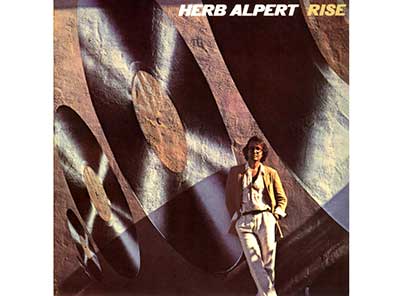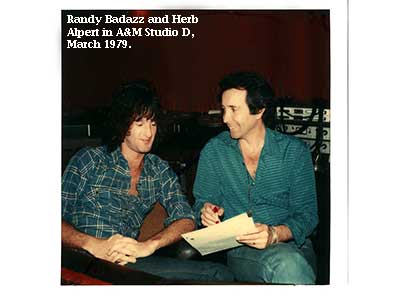CLASSIC TRACK: “RISE,” HERB ALPERT

Readers may recall that 1978 was the height of the Platinum-selling, Saturday Night Fever-fueled, aesthetically divisive disco craze. While rock and punk artists turned their anti-disco rebellion into money, major-labels scrambled for ways to capitalize on the success of the Bee Gees, Donna Summer and others. New and established artists alike were persuaded to give their records a disco feel.
This is the story of a song that grew from the notion of Herb Alpert cutting his own disco record, but ended up being something more sultry and groundbreaking: the Number One instrumental smash “Rise.”
“One of our A&R directors at A&M Records mentioned to Randy that we should do some of our old Tijuana Brass tunes with a disco beat,” recalls Alpert. [“Randy” is the famed trumpet player’s nephew, Randy Alpert, aka Randy Badazz—an award-winning music producer in his own right.]
“That was in December of ’78, and at that point, I had never worked with Herbie,” Badazz says. “When I decided to pursue a career in music, I wanted to go my own way. That’s why I changed my name to Badazz.
“At that time, I was cutting some funk records for Columbia, but one day Kip Cohen with A&M came to me and said, ‘I’m trying to get your uncle to do a dance-type record,’” Randy continues. “I wasn’t sure I wanted to be involved, but that night I was working at the old Record Plant on Third Street, and I ran into my friend Billy Preston. I told him what was going on and that I wanted to do things on my own, but Billy said something that stuck with me.
“He said, ‘Randy, there’s only a few people who touch mass amounts of people with their music. When I worked with The Beatles—John Lennon and Paul McCartney—they touch people. Ray Charles is that way; he touches people. Your uncle does that with his horn. So, all you need to do is do your thing, which is make funk records. Change the frame around the picture.”
The idea of recasting Herb Alpert and the Tijuana Brass’ classic tunes as disco songs was instantly unappealing to both Alperts. “I thought, those things were evergreen and they had their place in history,” Herb says.
Badazz adds, “Disco was not my favorite thing. But Kip said, ‘Just try a couple of songs and see how it goes.’ I had a studio in my house, and my writing partner, Andy Armer, and I thought let’s write a couple of new tunes as well. We wrote one called ‘Rise,’ and another called ‘Rotation,’ and we worked up versions of [Herb Alpert and the Tijuana Brass’ songs] ‘Lonely Bull’ and ‘Spanish Flea.’”
“Randy mentioned to me that he’d been asked to do this, and he said, ‘Hey, Unc, if you don’t do it, somebody else is liable to do it,’” Herb recalls. “So we agreed to give it a try. One thing that made me glad to get into the studio to do this was, the 3M company had loaned us their new 32-track digital machine. I wanted to try that out.”
In 1978, Herb Alpert’s engineer was Don Hahn, a New York native who had come up in Phil Ramone’s A&R Recording and then moved to L.A. to work at A&M at Alpert’s request.
“I moved to L.A. to work with Herb in February 1977,” Hahn says. “I drove across the country with my wife and three kids in a ’60s Cadillac. I started at A&M as senior mixer, then I became director of operations, and then I became vice president and general manager.”
Hahn knew A&M’s rooms and equipment well by the time the “Rise” sessions took place in the Quad 8 console-equipped Studio D on March 6, 1979, but the digital recording technology was new as could be. A&M was one of only a few studios that had one of the new recorders.
“Giorgio Moroder had one of those machines, and I think maybe The Eagles, and Disney,” Badazz says. “The machine sounded phenomenal—no tape hiss, no noise—but it was nothing but problems. When we were recording, there were three guys from 3M standing by in the control room.”
“Amigo also had the 3M machine,” adds Hahn. “When we had to make transfers, we had to go to one of those other studios, or they came to us, because we just had the one.”
Alpert’s “disco” sessions had begun a couple weeks before, with the jazz trumpeter and a band he and Badazz had selected—bass player Abraham Laboriel, drummer Steve Schaeffer, guitarists Tim May and Chris Pinnick, piano player Mike Lang, marimba and vibes player Julius Wechter, and Armer on Fender Rhodes—experimenting with a couple of disco Tijuana Brass tunes.
“I think we started by playing ‘A Taste of Honey’ or ‘Tijuana Taxi,’” Alpert says. “And it just felt like the wrong approach. I didn’t feel comfortable playing that way. We still had some time, so we decided to try cutting ‘Rise.’”
“He said he liked ‘Rise,’ so we started running it down at 120 beats per minute,” Badazz says. “I was really happy with it, but Herb said, ‘Let’s try slowing this thing down. We went down to 100 beats per minute, and it was like magic. When it got slower, it got really funky.”

Hahn says that rhythm tracks for “Rise” were laid down first, with Alpert playing trumpet live, as well. His go-to miking scheme at that time included Sennheiser MD421 on kick drum, Neumann KM 84 on hi-hat, AKG C12s as overheads, and Shure 57s on toms and snare. He used Neumann U 87s on Wechter’s instruments. Laboriel’s heavy four-on-the-floor bass—an essential ingredient—was taken direct.
“Abe’s playing was really cool,” Alpert says. “There was something about it that just made you move. I remember watching Abe in the studio, and he was dancing around while he was playing that incredible bass line.”
Hahn’s excellent record keeping indicates that further rhythm parts were added on March 8. “That might have been when we did the slide sounds on the bass and those heavy boom boom booms on drums,” he says. “Those drums—that’s a case of working with something till you get it right. I don’t remember what kind of mic I used or what the distance was, because you just keep trying it—at a foot, at three feet, at 10 feet—till everybody says, ‘Yeah, that’s it. Don’t touch it.’”
Another hallmark of “Rise” is the reverberant handclaps. “I think we overdubbed those six or eight times,” Hahn says. “I probably put one or two C12s up in the room, and we’d move the people around. It was like recording a vocal group. First you record them in one position, and then you switch them around and back them up, so you get a different perspective each time.
“I think there were six or so guys to start with, but eventually we had everybody in the building clapping—maybe even Effie the cleaning lady. In the end, everybody was clapping but me and my assistant, Don Koldon, because we had to run the machine. Then later I used an Eventide Harmonizer on it.”
“Originally when I suggested handclaps, Herb said, ‘What do you want hand claps for?” Badazz says. “Handclaps seemed like something old-fashioned to him. But I said, ‘No, let’s do huge handclaps, like you’re in a disco and 100 people are clapping their hands.’ I don’t think Herb had been in a disco at that point, but Herb has always been really cool about trying new stuff. “
Alpert has always been an artist who keeps stretching, but he knows what will and what won’t work for his sound. That is why he used the same type of mic—a Sony C37—for his trumpet for many years. It’s why he brought Hahn from New York to run his studios. And, of course it’s why he and Jerry Moss built the A&M label and studios to begin with:
“We had a great acoustician in Vincent Van Haaff,” Alpert says. “Studio D had a very natural, musical, warm sound. All of our studios, the minute you walked in, you felt comfortable. That has to do with the acoustics, but it’s also a fact that if you don’t feel good in a place, that ends up translating into, ‘I don’t think this sounds good.’”
Alpert says he liked the Sony mic he used for years because it captured a mellower trumpet sound. “It didn’t have those screaming high frequencies,” he says.
All of the inputs on “Rise” were recorded through the mic preamps in the Quad 8 console, and before the track could be edited and mixed, everything was backed up to an MCI 24-track analog machine because, Hahn points out, “You couldn’t edit in a digital machine. It wasn’t invented yet. We’d do our edits, and then transfer it back to digital if we were going to do more overdubs.”
During the mix, Hahn played with the sounds using what he says his assistants used to call ‘Don Hahn’s toy store.’ “They would put up a whole bunch of Harmonizers and tape delays and all sorts of gizmos. I know I probably used a Fairchild on the bass,” the engineer says. “That was my favorite toy since I started in the business. We used dbx limiters, LA-2A compression. We may have had some outboard API EQs. On kick, I think I used an Orban, which you couldn’t give away these days. And probably an EMT 140 reverb. We had a lot of toys, and it was just a fun session. Randy, Andy, Herb—they’re really creative people.
“And now I have these plaques on my wall,” Hahn continues. “I got a Gold record, and a Platinum record, and another one that 3M sent me that says, ‘Presented to Don Hahn to commemorate the first certified Gold record ever recorded on a digital tape machine for the A&M hit single, “Rise.”’”
“Rise” became Herb Alpert’s first Number One record since the Tijuana Brass years and won a 1979 Grammy Award for Best Pop Instrumental Performance. It was actually the first all-instrumental song that Badazz had ever written—not bad for a first try.
Alpert points out that the song’s success was bolstered by its use in the infamous Luke and Laura rape scene on ABC-TV’s soap opera General Hospital.
“That was instrumental in moving it up the charts,” Alpert says. “But that song never would have happened without Randy’s involvement. The melody is beautiful, the changes are beautiful, and Randy’s ideas for the handclaps and other things in the studio put it over the top.”
